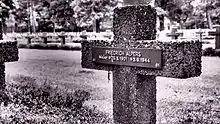Friedrich Alpers
Friedrich Alpers (25 March 1901 – 3 September 1944) was a German Nazi politician and SS-Obergruppenführer.[1] He was also a Minister of the Free State of Brunswick,[2] and Generalforstmeister (General forest supervisor).[3][4] Alpers was responsible for numerous political crimes in Brunswick. Alpers committed suicide in 1944, while in US custody.

Friedrich Alpers | |
|---|---|
| Born | 25 March 1901 Sonnenberg, Germany |
| Died | 3 September 1944 (aged 43) Mons, Belgium |
| Buried | |
| Allegiance | |
| Service/ | Luftwaffe |
| Rank | SS-Obergruppenführer |
| Service number | NSDAP #132,812 SS #6,427 |
| Battles/wars | World War II |
| Awards | Knight's Cross of the Iron Cross |
NSDAP and SS career
Born in 1901, Alpers studied law and political science at the Heidelberg University, Ludwig Maximilian University of Munich and University of Greifswald. He became a lawyer in 1929. In June 1929, Alpers joined the Nazi Party (NSDAP membership number 132,812). In May 1930 he joined the Sturmabteilung (SA). On 1 March 1931 he joined the SS (membership number 6,427). He was an active member in the SS, rising to the rank of Obergruppenführer. Since October 1930, he was Minister of the Brunswick State Parliament. Alpers was twice temporarily suspended from the SS in 1933 following complaints of excessive violence made against him during the Nazi takeover of Brunswick.
Minister of the Free State of Brunswick
After the Nazi seizure of power, Alpers became Finance and Justice Minister of Brunswick on 8 May 1933 (a position in which he served until 1934) under the Ministerpräsident Dietrich Klagges. Along with Klagges and Friedrich Jeckeln, Alpers was one of the main persons responsible for the Gleichschaltung and persecution of political opponents in the Free State of Brunswick.
Subordinated to Alpers was Klagges "Hilfspolizei" ("Auxiliary Police"). This force was directly answerable to Klagges and consisted of SA, SS and Der Stahlhelm men. On 4 July 1933, Alpers was directly involved in the Rieseberg Murders of eleven communists and labor organizers in Rieseberg, about 15 miles (24 km) east of Braunschweig.
Awards
- German Cross in Gold on 9 April 1942 as Hauptmann in the 3.(F)/Aufklärungs-Gruppe 121[5]
- Knight's Cross of the Iron Cross on 14 October 1942 as Major and commander of Fernaufklärungs-Gruppe 4[6]
See also
References
Citations
- Browder 2004, pp. 94–95.
- Humphrey 1951, p. 285.
- Kreis 2000, p. 185.
- Kay 2011, p. 17.
- Patzwall & Scherzer 2001, p. 14.
- Scherzer 2007, p. 190.
Bibliography
- Browder, George C. (2004). Foundations of the Nazi Police State: The Formation of Sipo and SD. University Press of Kentucky. ISBN 978-0-8131-9111-9.
- Humphrey, Richard D. (1951). Georges Sorel, prophet without honor: a study in anti-intellectualism. Harvard University Press.
- Kay, Alex J. (2011). Exploitation, Resettlement, Mass Murder: Political and Economic Planning for German Occupation Policy in the Soviet Union, 1940–1941. Berghahn Books. ISBN 978-0-85745-165-1.
- Kreis, Georg (2000). Switzerland and the Second World War. Routledge. ISBN 978-0-7146-5029-6.
- Patzwall, Klaus D.; Scherzer, Veit (2001). Das Deutsche Kreuz 1941 – 1945 Geschichte und Inhaber Band II [The German Cross 1941 – 1945 History and Recipients Volume 2] (in German). Norderstedt, Germany: Verlag Klaus D. Patzwall. ISBN 978-3-931533-45-8.
- Patzwall, Klaus D. (2004). Das Goldene Parteiabzeichen und seine Verleihungen ehrenhalber 1934–1944 (in German). Norderstedt, Germany: Verlag Klaus D. Patzwall. ISBN 3-931533-50-6.
- Scherzer, Veit (2007). Die Ritterkreuzträger 1939–1945 Die Inhaber des Ritterkreuzes des Eisernen Kreuzes 1939 von Heer, Luftwaffe, Kriegsmarine, Waffen-SS, Volkssturm sowie mit Deutschland verbündeter Streitkräfte nach den Unterlagen des Bundesarchives [The Knight's Cross Bearers 1939–1945 The Holders of the Knight's Cross of the Iron Cross 1939 by Army, Air Force, Navy, Waffen-SS, Volkssturm and Allied Forces with Germany According to the Documents of the Federal Archives] (in German). Jena, Germany: Scherzers Militaer-Verlag. ISBN 978-3-938845-17-2.